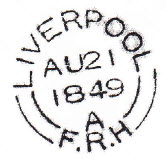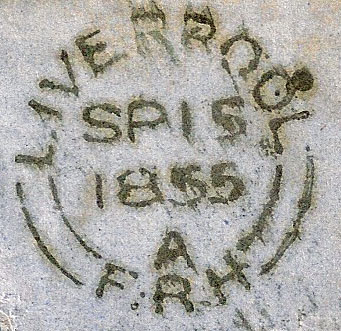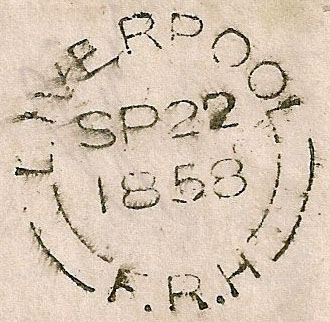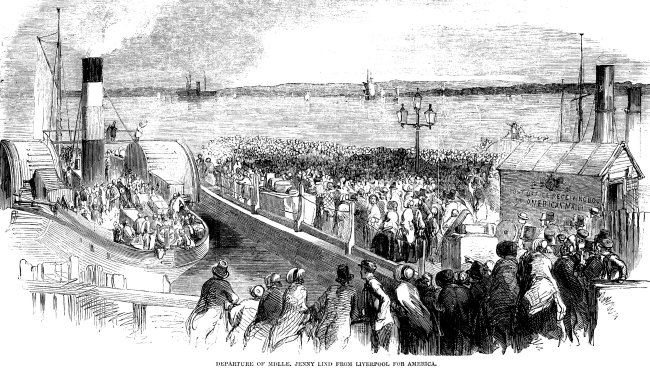Seapost -> Cunard Line -> Liverpool Floating Receiving House marks census
Liverpool Floating Receiving House marks
By Julian Tweed and Julian Jones
On 31 May 1847, what the Illustrated London News described as "this stupendous work" was launched and moored opposite St George's Pier Head at Liverpool and connected to it by two iron bridges. The description was of the new floating landing stage; at some 508 feet long and 82 feet wide it was then the largest such structure in the world, allowing steamers to moor in deep water at any stage of the tide.
Soon a clerk at the Liverpool Post Office, a Mr Brownless, proposed a plan for a receiving house to be set up on the landing stage to allow the last minute posting of letters on departing transatlantic vessels. The so-called Floating Receiving House was in place by August 1849. A double ring circular date-stamp reading "LIVERPOOL / F.R.H" was sent out from London and the late fee set at one shilling (1/-).
However, in 1859 improved railway links resulted in the main port of exit for transatlantic mail being moved from Liverpool to Queenstown (Cobh) in southern Ireland. Despite the late fee at the Floating Receiving House being reduced in September 1859 to 6d, its use rapidly declined and the facility was withdrawn in October 1864.
Examples of the proofcopy and used examples of the handstamp with and without the 'A' index.



A typical cover of the period may be seen here.
The left side of the image From the London Illustrated News, August 24th 1850 depicts the popular singer Jenny Lind waving a handkerchief while standing on the paddle box of the tender which will take her out to Collins Line's Atlantic for her voyage to the USA. The Liverpool Floating Receiving House may be seen on the right hand side of the picture bearing the legend "POST OFFICE RECEIVING HOUSE / AMERICAN MAIL".

The mail bags collected from the Receiving House would go aboard on the last journey of the tender before the steamship sailed.
The reported covers bearing this mark have been tabulated with input from GB and the USA by collectors known to keep such records. We acknowledge our thanks to the following for their help in constructing the census: Colin Tabeart, Richard Winter, Reg Gleave, Andrew Reid and Graham Booth.
Census of Liverpool Floating Receiving House marks recorded to date
The list is provided as a PDF document which may be viewed online or downloaded for printing, reference and review.
List of known Liverpool Floating Receiving House marks, by Julian Tweed, download:
![]() (0.2Mb)[December 2021 edition]
(0.2Mb)[December 2021 edition]
To save the document you are recommended to click on the download icon with your right mouse button and select the 'save link as / save target as' function to save the document directly to a folder on your computer hard drive.
Postscript - Liverpool Landing Stage
An article in the Liverpool Daily Post of 10th Feb 1956 reported that the Landing Stage Post Office opened on 28th Feb 1879 and closed 31st December 1955. This landing stage was increased in size over the years to the extent that transatlantic liners could moor directly to the landing stage. (In the period of the F.R.H mark up to 1864, it was necessary for the liners to moor offshore. Passengers and mail were transferred to the landing stage by tender.) An article in the 14th May 1895 New York Sun reported that improvements due to be completed that week to the landing stage would both eradicate the journey by tender and the cab ride across the city to the (Liverpool Lime Street) railway station. Henceforth the ocean liners could moor against the landing stage at any tide and passengers could walk a mere 50 yards from the ship, through the new Custom House to a seat on the train.
From about 1878 a new series of handstamps became available in conjunction with this post office: 'LIVERPOOL / LANDING STAGE' (Tabeart M18a); 'LANDING STAGE / LIVERPOOL' (M18); 'LANDING STAGE LIVERPOOL / LATE FEE' (M19) and 'LANDING STAGE B.O. LIVERPOOL' (M20).

References:
Tweed, J: The Liverpool Floating Landing Stage Receiving House – The 6d Late Fee, TPO Journal Vol 68 No. 1 (Spring 2014), TPO & Seapost Society, 2014
Tabeart, C: Robertson Revisited, James Bendon, Ltd., Limassol, 1997
Tabeart, C: Robertson Revisited A Supplement, TPO & Seapost Society, 2012
Stitt-Dibden, W. G.: Late Fee and Too Late Stamps, 1966

